Understanding Top Down Budgeting Vs. Bottom Up Approaches
Learn the key differences between top down budgeting and bottom up budgeting, their pros, cons, and how to choose the right approach for your organization.
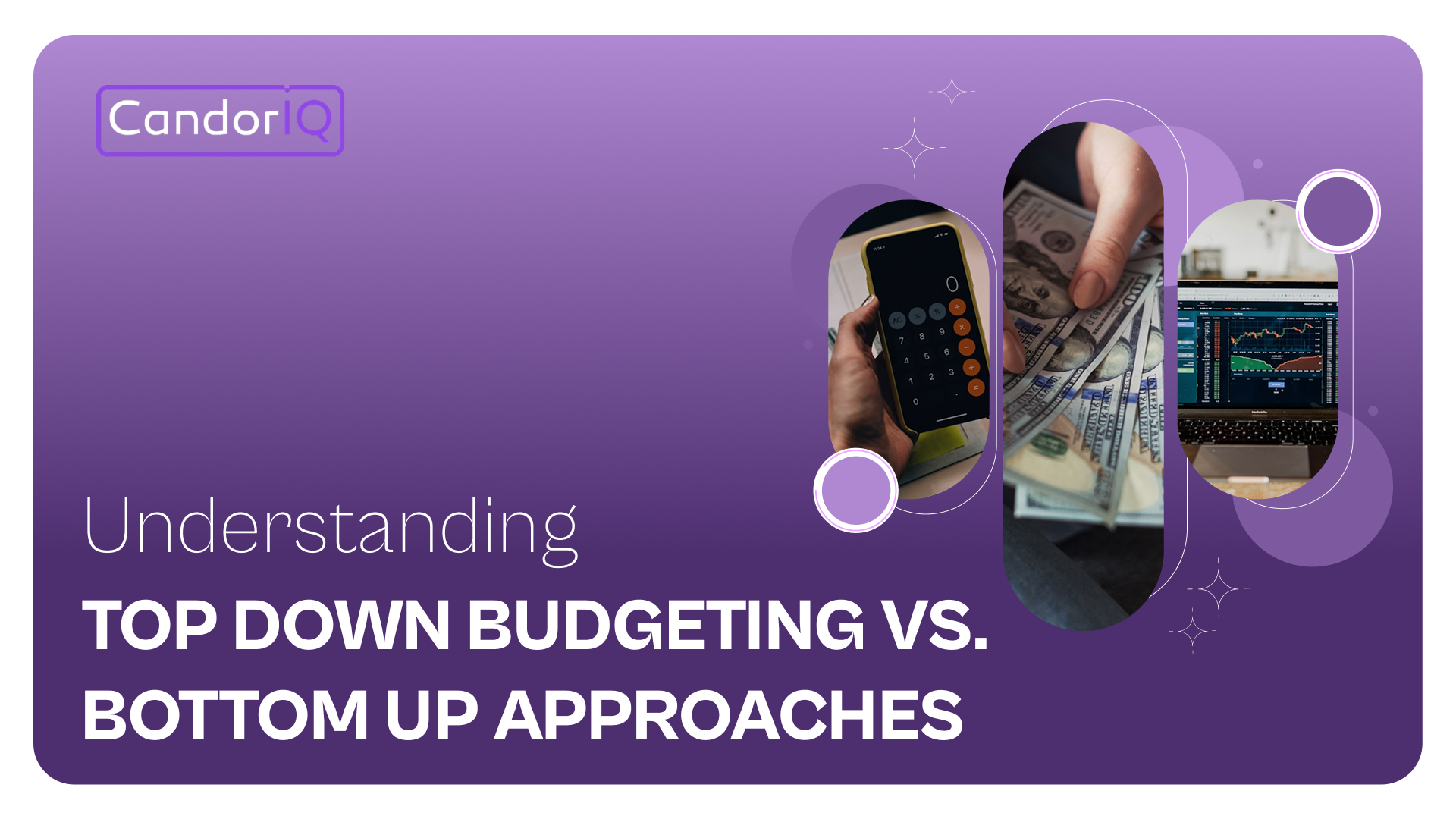
When it comes to budgeting, organizations often face the decision of whether to use a top down budgeting or bottom up budgeting approach. Both methods have their strengths and weaknesses, and choosing the right one can have a significant impact on how resources are allocated and the overall financial planning process.
Understanding the core differences between these approaches will help your organization decide which method or combination of methods will best support your financial planning and help achieve strategic goals.
TL;DR
- Top down Budgeting: A centralized approach where senior management sets the budget based on overall strategic goals.
- Bottom Up Budgeting: A decentralized approach where departments create their budgets, resulting in more detailed insights.
- Key Differences: Top down is faster and aligned with company goals, while bottom up is more accurate and involves employee input.
- Hybrid Approach: Combining top down and bottom up methods can offer a balanced solution, ensuring both strategic alignment and departmental needs.
- Choosing the Right Approach: The best approach depends on your organization’s size, culture, and strategic goals.
What is Top Down Budgeting?
Top down budgeting is a financial planning method where senior management sets the overall budget based on the company’s strategic goals, and departments are allocated funds accordingly. This approach ensures that the budget aligns with high-level organizational objectives.
Example: In large manufacturing companies, top down budgeting is commonly used, where corporate executives determine the overall budget based on strategic initiatives like production targets, then allocate portions to different departments such as sales, operations, and marketing.
This centralized method allows the company to maintain uniformity in its financial planning, ensuring that every department aligns with the broader company goals.
Next, let’s see how the bottom up budgeting approach works.
What is Bottom Up Budgeting?
Bottom up budgeting is a financial planning method where each department contributes to the budget, allowing for a more accurate and detailed allocation of resources based on their specific needs and objectives.
In technology firms or startups, bottom up budgeting is often used to gather input from various departments, such as product development and marketing. These teams create their budgets based on projected costs and revenue, which are then combined to form the overall company budget.
This approach ensures that each department’s unique needs are considered and prioritized.
Now that we understand both approaches, let’s explore the key differences between top down and bottom up budgeting.

Key Differences Between Top Down and Bottom Up Budgeting
To effectively decide between top down and bottom up budgeting, it’s essential to understand how each approach compares across various criteria. The table below highlights the key differences in accuracy, time efficiency, employee engagement, and other important factors.
To better understand when and how to apply top down budgeting, let’s weigh its key benefits and potential drawbacks.
Advantages & Disadvantages of Top Down Budgeting
When considering top down budgeting, it's essential to evaluate both its benefits and challenges to understand when it’s the right approach for your organization. Here’s a look at the pros and cons:
Advantages:
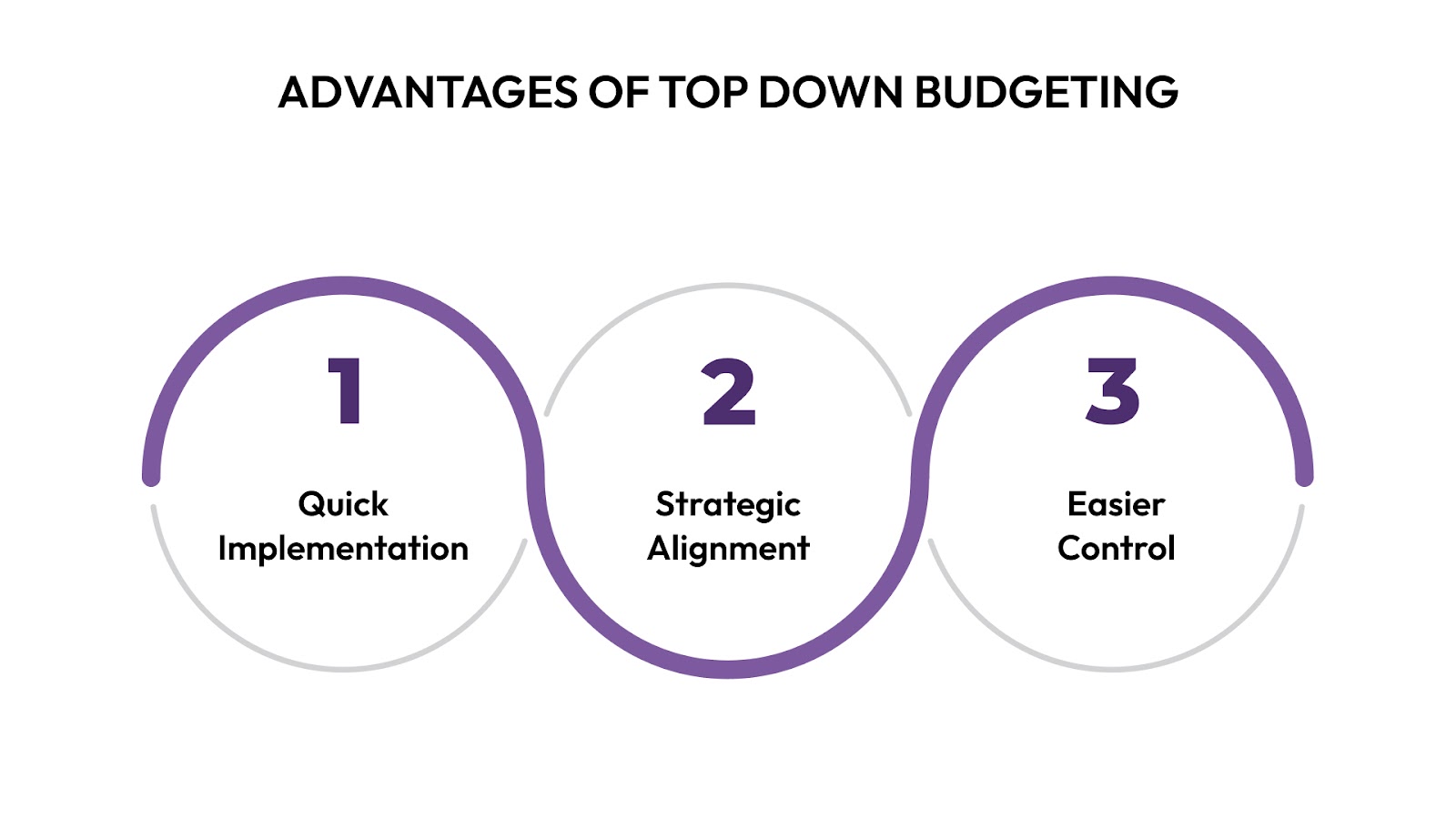
- Quick Implementation: As the budget is set by senior management, it’s faster to roll out, making it ideal for large organizations needing quick decision-making.
- High Alignment with Corporate Strategy: Since the budget aligns with company goals, there is a clear direction for every department, reducing ambiguity.
- Easier Control: Senior management oversees the entire process, ensuring that resource allocation remains aligned with overall strategic objectives.
Disadvantages:
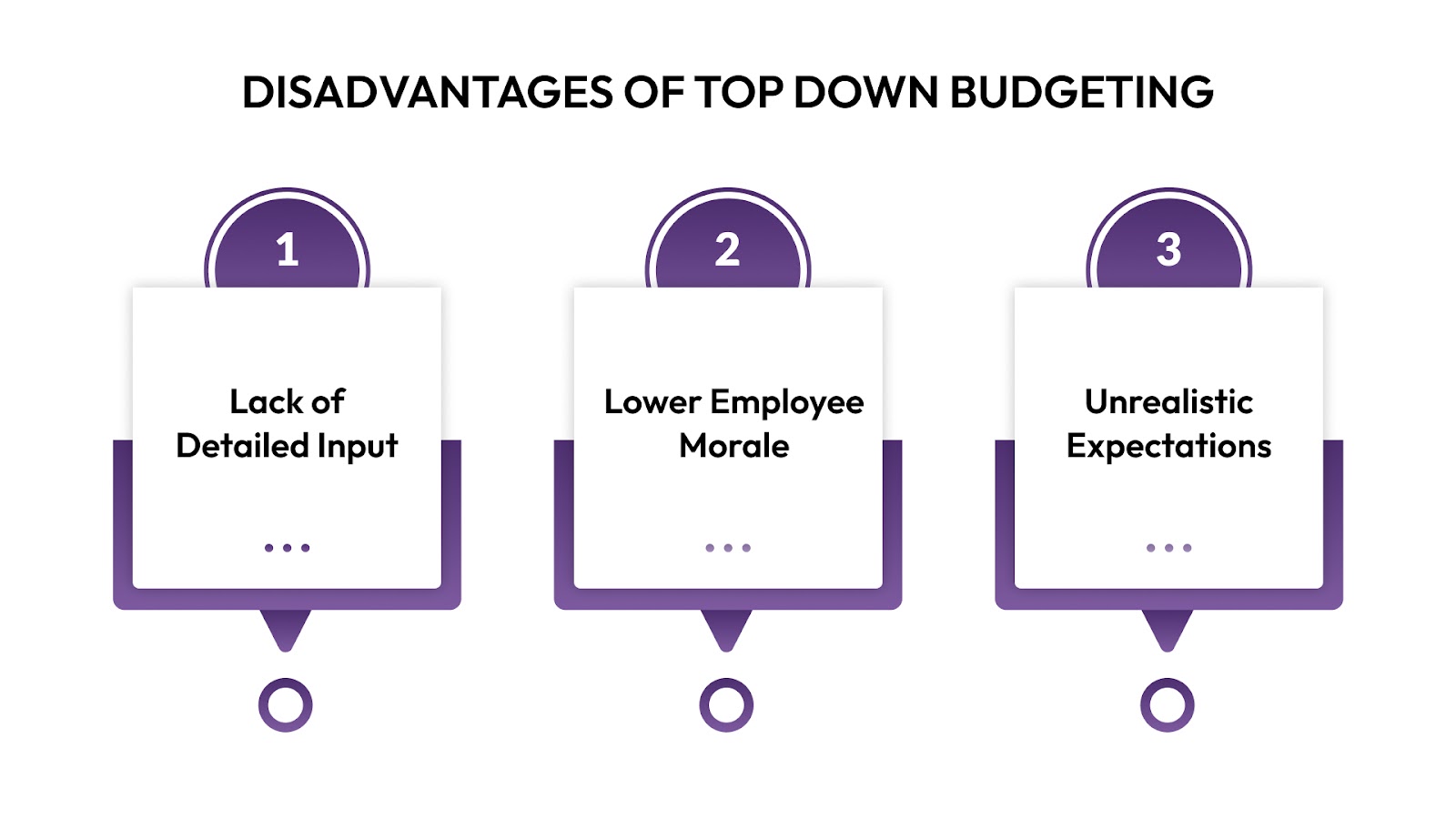
- Lack of Detailed Input: With limited input from departments, top down budgeting may miss out on crucial operational insights that could improve accuracy.
- Lower Employee Morale: Departments may feel excluded from the process, leading to resistance and lower engagement in executing the budget.
- Unrealistic Expectations: Without in-depth knowledge of departmental constraints, management may set targets that are difficult or impossible to meet.
Shifting focus to bottom up budgeting, let's examine how its collaborative approach benefits organizations, along with the challenges it presents.
Advantages & Disadvantages of Bottom Up Budgeting
Bottom up budgeting offers a more detailed and participatory approach, but it also comes with its own set of challenges that should be considered. Here’s an overview of its advantages and disadvantages:
Advantages
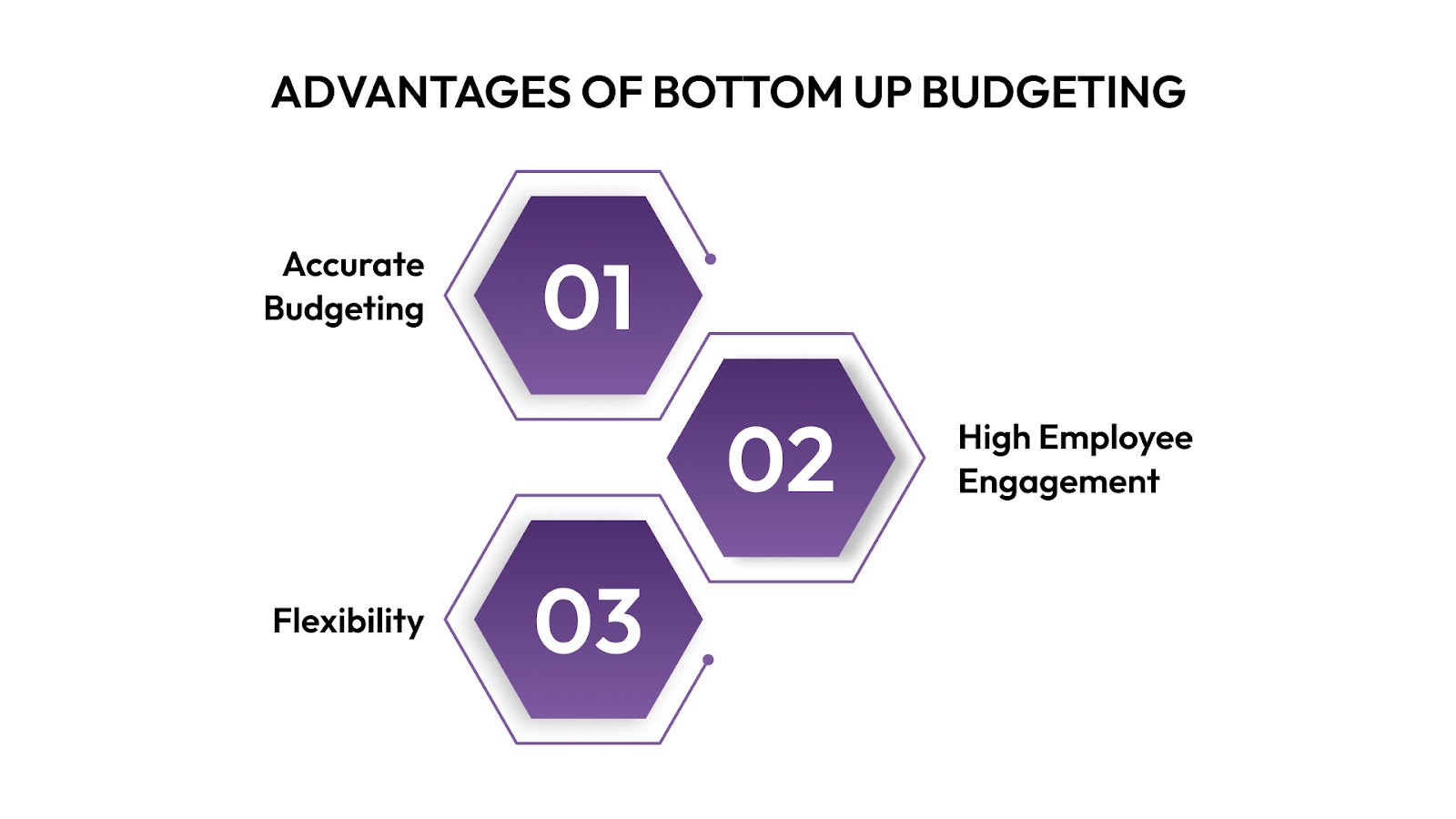
- Greater Accuracy and Realistic Budgeting: Departments provide detailed input, ensuring the budget reflects actual needs and challenges, leading to more realistic allocations.
- High Employee Engagement: Involving employees in the budgeting process increases buy-in and motivation, leading to a more committed workforce.
- Flexibility: This approach is adaptable to changing circumstances, allowing for adjustments based on real-time needs and conditions.
Disadvantages
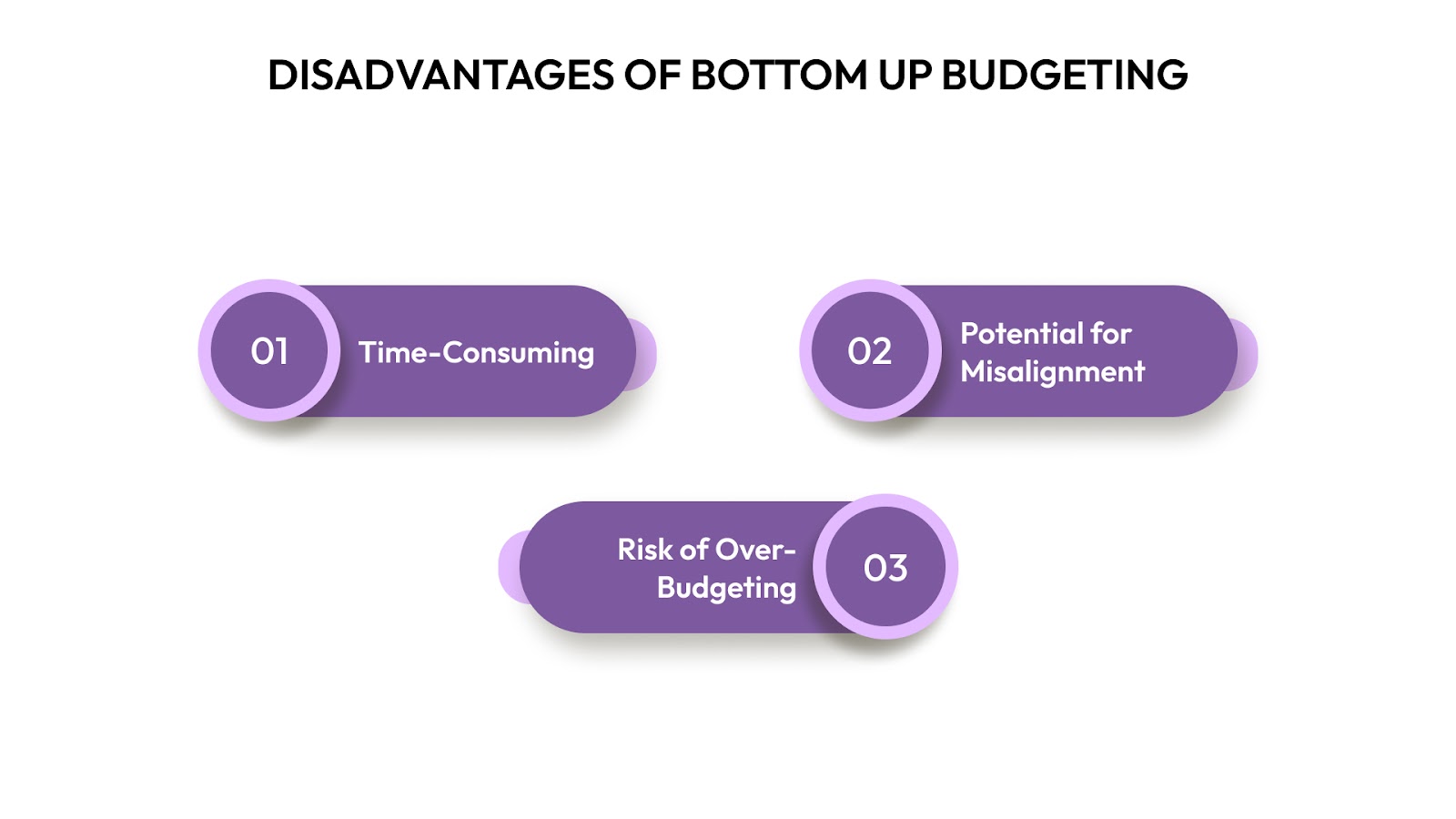
- Time-Consuming: The process involves multiple departments and iterations, making it resource-intensive and lengthy.
- Potential for Misalignment: As departments focus on their own needs, the budget may deviate from the company’s strategic goals.
- Risk of Over-Budgeting: Departments may request more resources than necessary, leading to inflated budgets and inefficiencies.
To address the limitations of each approach, many organizations adopt a hybrid approach. Let’s understand how it works.
Hybrid Approach: Combining Top Down and Bottom Up Budgeting
The hybrid approach blends both top down and bottom up budgeting, allowing management to set strategic goals while giving departments the flexibility to offer valuable input. This method aims to create a balanced and adaptable budgeting process.
- Combines Efficiency with Detail: The hybrid approach merges the quick implementation of top down budgeting with the detailed insights of bottom up budgeting, offering the best of both worlds.
- Employee Engagement and Strategic Alignment: It enhances employee involvement while ensuring that the budget aligns with the company’s high-level goals, fostering a sense of ownership and alignment.
Selecting the right budgeting approach requires careful consideration of the factors at play. Next, let’s find out the best approach for your company.
Choosing the Right Budgeting Approach for Your Organization
The right budgeting approach depends on various factors unique to your organization. Here’s a closer look at what to consider when choosing between top down and bottom up budgeting:
1. Organization Size
Larger, centralized organizations benefit from top down budgeting, as it allows for faster decision-making and ensures uniformity across departments. On the other hand, smaller organizations or those with more decentralized operations may find bottom up budgeting more effective.
It allows departments to have a direct hand in resource allocation, ensuring the budget is more accurate and aligned with on-the-ground realities.
2. Industry
The industry you operate in plays a significant role in choosing the right budgeting approach. Companies in stable, predictable sectors such as manufacturing or retail often opt for top down budgeting to maintain control and consistency.
Meanwhile, sectors that require continuous innovation, like technology or pharmaceuticals, often prefer bottom up budgeting to foster creativity and gain detailed insights from those directly involved in projects.
3. Company Culture
The culture of your organization will also impact your choice. In highly collaborative, open organizations, bottom up budgeting is a natural fit because it encourages team involvement and allows employees at all levels to contribute.
However, more hierarchical organizations with a clear top down structure may find that top down budgeting aligns better with their leadership style and decision-making processes.
Understanding the factors that influence your budgeting approach is key, but it's equally important to address the challenges that can arise during implementation.
Overcoming Challenges in Budgeting
Both top down and bottom up budgeting approaches come with their own set of challenges. Recognizing these problems early on and taking steps to address them can help ensure a smoother budgeting process.
Potential Problems with Both Approaches
Each budgeting method has its drawbacks, and understanding these issues can help you decide how best to implement them.
For the Top Down approach, one of the main challenges is resistance from lower-level employees who may feel excluded from the decision-making process. Additionally, a lack of detailed insight from the department level can lead to misallocation of resources, while the risk of misalignment with department-specific needs can create inefficiencies.
The Bottom Up approach, on the other hand, can lead to over-budgeting, as departments may inflate their needs to secure more resources. Managing multiple departmental budgets can become complex and time-consuming.
How to Address These Challenges
By understanding the challenges, you can take proactive steps to resolve them and create a more efficient budgeting process.
- Encourage open communication: Ensuring continuous dialogue between departments and senior management helps balance insights and address resistance, leading to better collaboration and alignment.
- Use a hybrid approach: Combining elements of both top down and bottom up budgeting can reduce the risks associated with each. Set high-level strategic goals while allowing for departmental feedback to ensure the budget is both realistic and aligned with the company’s needs.
With a solid understanding of the challenges, the next step is to focus on how to successfully implement your budgeting strategy.
Implementing Your Budgeting Strategy
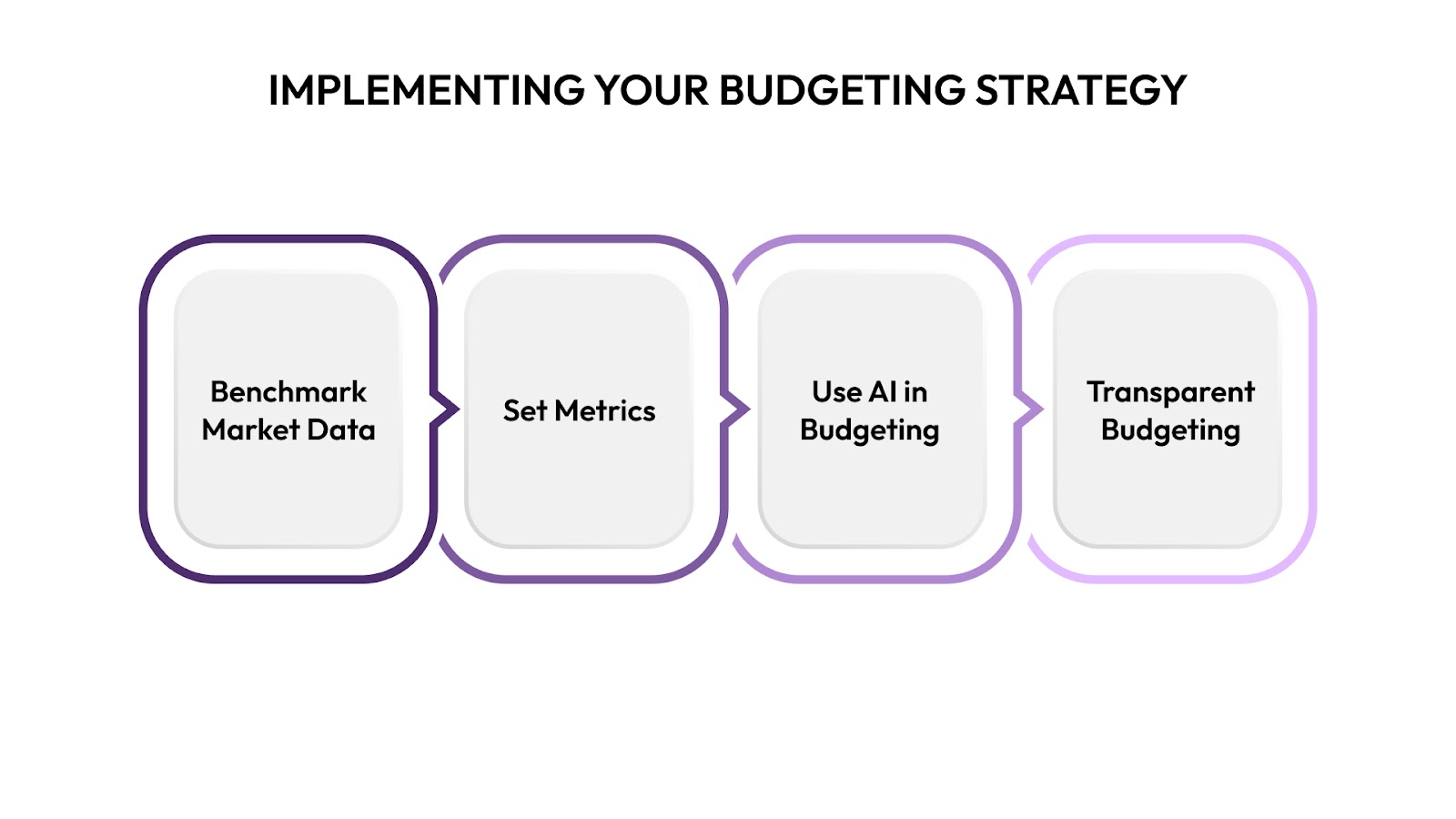
Successful implementation of top down or bottom up budgeting requires a structured approach. Here’s a step-by-step guide to ensure your budgeting process is efficient and effective.
Step 1: Benchmark Market Data
Begin by benchmarking your market data against industry standards. This helps ensure that your budget allocations align with current market trends and that your financial targets remain competitive.
Accurate market data will help you set realistic goals for both revenue and expenditures.
Step 2: Define Clear Performance Metrics
Clearly define performance metrics that link directly to budget allocations. These metrics should be specific and measurable, helping ensure that financial resources are directed towards areas with the greatest potential for growth and efficiency.
This alignment between performance and budgeting leads to a more focused use of resources.
Step 3: Use AI in Budgeting
Incorporate AI into your budgeting process to gain data-driven insights. It can help you identify trends, forecast future budgetary needs, and automate certain budgeting tasks, making the process faster and more accurate.
Using AI can reduce human error and provide real-time adjustments to your financial plans.
Step 4: Communicate the Budget Transparently
Effective communication is key to successful budget implementation. Make sure that the budget is shared clearly across the organization. By keeping everyone informed, from top management to department heads, you ensure that everyone understands their role in meeting financial goals and can make adjustments as needed.
To make this process even smoother, adopting a unified platform can help improve coordination and ensure your budgeting strategy is implemented effectively across all departments.

How Candor Can Help with Budgeting
A unified platform like CandorIQ can significantly improve your budgeting process by enhancing accuracy, efficiency, and alignment across departments.
- Compensation & Payband Builder: This tool helps you create geo-adjusted pay bands, ensuring that your budget allocations are accurate and reflect the different salary needs based on location and department.
- AI-Powered Insights: CandorIQ’s AI features allow you to track budget utilization, forecast future headcount needs, and make informed, data-driven decisions that align with company goals.
- Real-Time Collaboration: With CandorIQ, HR, finance, and leadership can collaborate seamlessly, ensuring all departments are aligned with the overall budget strategy and financial objectives.
Start improving your budgeting process with CandorIQ today!
FAQs
Q1. How can bottom up budgeting lead to better employee engagement?
A1. Bottom up budgeting allows employees to contribute to the budgeting process, which increases their sense of ownership and involvement. This high level of engagement helps employees feel valued, leading to greater motivation and alignment with organizational goals.
Q2. What is the main benefit of using top down budgeting in large organizations?
A2. Top down budgeting is well-suited for large organizations because it simplifies the decision-making process, ensuring faster implementation and better coordination with high-level company goals. This efficiency is key in managing complex, multi-departmental budgets.
Q3. How can bottom up budgeting be better suited for industries requiring innovation?
A3. Industries like technology or pharmaceuticals, where innovation is crucial, benefit from bottom up budgeting because it allows for detailed insights from those closest to the work. This enables more accurate allocation of resources to foster creativity and product development.
Q4. How does top down budgeting align with corporate strategy?
A4. Top down budgeting ensures that financial resources are directly allocated to support the company's strategic goals. Senior management sets priorities that guide departments, aligning the overall budget with long-term objectives and high-level corporate strategy.
Q5. Why do some companies combine top down and bottom up budgeting?
A5. By combining top down and bottom up budgeting, companies can maintain strategic alignment while incorporating detailed department-level insights. This hybrid model balances efficiency with thorough input, leading to more accurate, actionable budgets.


